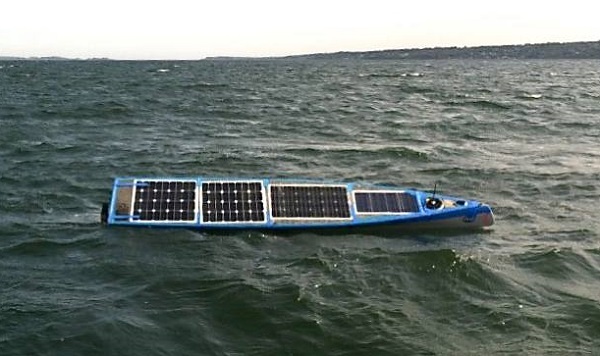It was an audacious undertaking, an engineer-nerd project nonpareil, a bunch of college students building a robotic solar-powered boat and setting it off on a voyage across the Atlantic Ocean. And amazingly, after a few delays, it’s on its way.
The vessel Scout was launched from just off Sakonnet Point, R.I., in the early morning hours of July Fourth. Last time we checked – Saturday morning – the 12.8-foot-long, 25-inch-wide boat had hop-scotched 72 miles from waypoint to waypoint to a spot 49 miles off the Rhode Island coast. That left Scout a mere, oh, 3,389 miles to go to reach its destination, Sanlucar de Barrameda, Spain, where 515 years ago a guy named Columbus began his own transatlantic voyage.

As far as the team knows, if Scout makes it, that would be a first for a boat of its kind. (We’ve seen long autonomous ocean crossings before, as with the Liquid Robotics’ “Papa Mau” that traveled from North America to Australia using a wave energy systems to propel itself.)
The entirely solar-powered Scout is following a preprogrammed route – which caused a little bit of an episode in the early going on Friday as Scout turned back west to hit a waypoint it had drifted past. When Facebook commenters, following the online tracking, expressed concern, the crew said not to worry – it was part of the plan and won’t happen again. The double-back “was intentional in the early stages of the trip, with islands and whatnot we want the boat to get to the point,” the crew explained on Facebook. “After this waypoint it will carry on east if it is past the longitude of the waypoint it’s aiming at.”
A couple of things make this project especially cool: First, while the project has sponsors and supporters, it is not affiliated with a company or university. It’s just a group of college guys bringing diverse design, building and engineering skills together to make something cool happen.
According to a piece in the local East Bay Newspapers, the idea originated with Tiverton, R.I., buddies Dylan Rodgriquez, a Worcester Polytechnic student, and Max Kramers, who is studying at La Escuela Superior de Ingenieros (TECNUN) in Spain. A handful of students from other colleges in the East make up the rest of the crew.
The second cool thing here: Scout was built from scratch. You can see how the whole process unfolded, beginning in April 2012, on the website, from a design for a hull, to building the form, to constructing the different aspects of the carbon fiber hull. And then there were the long hours of programming – two weeks of 15-hours-a-day crunching.